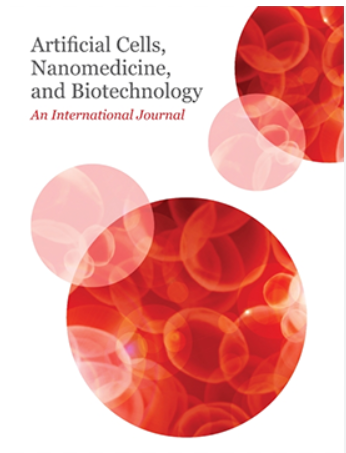聚乙二醇化绿金纳米颗粒在环磷酰胺性膀胱炎中的潜在应用
IF 4.5
3区 生物学
Q1 BIOTECHNOLOGY & APPLIED MICROBIOLOGY
Artificial Cells, Nanomedicine, and Biotechnology
Pub Date : 2022-12-01
DOI:10.1080/21691401.2022.2078340
引用次数: 2
摘要
摘要:我们研究了绿茶提取物聚乙二醇化金纳米颗粒(P-AuNPs)利用其靶向和持续给药治疗环磷酰胺(CYP)诱导的膀胱炎的作用。采用绿色合成的思路,将金盐与绿茶提取物还原反应合成AuNPs。合成的P-AuNPs多为球形,平均尺寸为14.3±3.3 nm。在注射CYP (150 mg/kg, i.p.)之前,先用P-AuNPs (1,10 mg/kg, i.p.)进行预处理,表明其具有泌尿保护作用。P-AuNPs显著逆转了CYP产生的所有疼痛样行为和毒性,导致天冬氨酸转氨酶、丙氨酸转氨酶、c反应蛋白和肌酐水平下降。P-AuNPs通过增加膀胱组织还原性谷胱甘肽、谷胱甘肽- s转移酶、过氧化氢酶和超氧化物歧化酶的水平和减少一氧化氮的产生来增强抗氧化系统。此外,它还能减轻低钾血症和低钠血症,同时减少膀胱组织和腹膜腔中的埃文斯蓝含量。P-AuNPs可显著减轻cyp诱导的膀胱组织损伤,马松三色染色显示膀胱平滑肌胶原纤维纤维化减轻。此外,P-AuNPs还可以预防血液学参数和临床评分的改变,这表明其具有尿保护作用。本文章由计算机程序翻译,如有差异,请以英文原文为准。
Potential applications of PEGylated green gold nanoparticles in cyclophosphamide-induced cystitis
Abstract We investigated the effect of green tea extract PEGylated gold nanoparticles (P-AuNPs) making use of its targeted and sustained drug delivery against cyclophosphamide (CYP)-induced cystitis. AuNPs were synthesized by reduction reaction of gold salts with green tea extract following the concept of green synthesis. Mostly spherical-shaped P-AuNPs were synthesized with an average size of 14.3 ± 3.3 nm. Pre-treatment with P-AuNPs (1, 10 mg/kg, i.p.) before CYP (150 mg/kg, i.p.) challenge suggested its uroprotective properties. P-AuNPs significantly reversed all pain-like behaviours and toxicities produced by CYP resulting in a decreased aspartate aminotransferase, alanine aminotransferase, C-reactive protein, and creatinine level. P-AuNPs increased anti-oxidant system by increasing the level of reduced glutathione, glutathione-S-transferase, catalase and superoxide dismutase, and reduced nitric oxide production in bladder tissue. Additionally, it attenuated hypokalaemia and hyponatremia, along with a decrease in Evans blue content in bladder tissue and peritoneal cavity. CYP-induced bladder tissue damage observed by macroscopic and histological findings were remarkably attenuated by P-AuNPs, along with reduced fibrosis of collagen fibre in bladder smooth muscles shown by Masson’s trichrome staining. Additionally, alterations in hematological parameters and clinical scoring were also prevented by P-AuNPs suggesting its uroprotective effect.
求助全文
通过发布文献求助,成功后即可免费获取论文全文。
去求助
来源期刊

Artificial Cells, Nanomedicine, and Biotechnology
BIOTECHNOLOGY & APPLIED MICROBIOLOGY-ENGINEERING, BIOMEDICAL
CiteScore
10.90
自引率
0.00%
发文量
48
审稿时长
20 weeks
期刊介绍:
Artificial Cells, Nanomedicine and Biotechnology covers the frontiers of interdisciplinary research and application, combining artificial cells, nanotechnology, nanobiotechnology, biotechnology, molecular biology, bioencapsulation, novel carriers, stem cells and tissue engineering. Emphasis is on basic research, applied research, and clinical and industrial applications of the following topics:artificial cellsblood substitutes and oxygen therapeuticsnanotechnology, nanobiotecnology, nanomedicinetissue engineeringstem cellsbioencapsulationmicroencapsulation and nanoencapsulationmicroparticles and nanoparticlesliposomescell therapy and gene therapyenzyme therapydrug delivery systemsbiodegradable and biocompatible polymers for scaffolds and carriersbiosensorsimmobilized enzymes and their usesother biotechnological and nanobiotechnological approachesRapid progress in modern research cannot be carried out in isolation and is based on the combined use of the different novel approaches. The interdisciplinary research involving novel approaches, as discussed above, has revolutionized this field resulting in rapid developments. This journal serves to bring these different, modern and futuristic approaches together for the academic, clinical and industrial communities to allow for even greater developments of this highly interdisciplinary area.
 求助内容:
求助内容: 应助结果提醒方式:
应助结果提醒方式:


